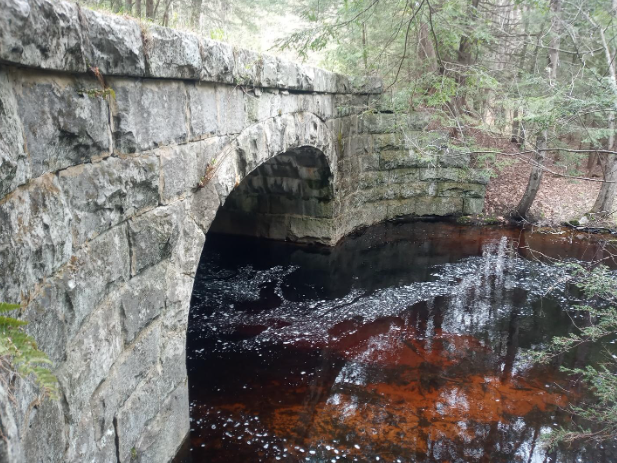
Figure 1. The stone arch bridge in Stoddard, NH, in Cheshire County can be seen beside Route 9 between Hillsboro and Keene. This is a very old example of a dry fit stone bridge with two arches.
After a previous article on covered bridges, it occurred to me that I had only scratched the surface of historical structures that make good excuses to ride rail trails or to detour to during your trip to or from a rail trail ride. Next subject: Stone Bridges! In many cases, unless you’re observant, or know where to look ahead of time, you could pass right over these handsome, historical bridges and not even know they are there! They get less attention than covered bridges which weather and need replacement, while stone bridges can go right on doing their job whether used, or unused, sometimes for hundreds of years. So, the search for stone bridges required a bit more detective work, mostly online, and collaborating with rail trail enthusiast and online-map maker, who was willing to make the map of stone bridges in New Hampshire. I hope that you’ll find these interesting and that these descriptions will both inspire you to enjoy some history and get some exercise on our great rail trails.
For the purposes of this article, there are essentially three different types of stone bridges: Those built before the ready availability of cement were “dry fit” together without mortar, as in Figure 1. These include those on the Cheshire Rail Trail in Keene (see figures 5,8,9,10 of a previous article: https://nhrtc.org/monadnock-region-rail-trails/) , as well as the some of those concentrated around Hillsborough (https://en.wikipedia.org/wiki/Five_Stone_Arch_Bridges,_Hillsborough,_New_Hampshire). Next came stone bridges built with mortar to hold the stones together. Examples of these include the Sawyer Bridge in Hillsboro that was built around 1866. The newest type of stone bridge is built with primarily cement but is faced with stone to make it appear as though it is made from stone. One of the most well documented of these bridges is the Henniker Stone Bridge (https://historicbridges.org/bridges/browser/?bridgebrowser=newhampshire/henniker/). Once one opens the door to stone-faced bridges the number in New Hampshire grows quite large. I recently saw an example of this type of bridge on Rt. 107 in Pittsfield (see Figure 2). This modern bridge, complemented its location on the Suncook River very well. It seems to me that towns would be well served by putting the extra effort/cost into making stone-faced bridges that enhance the river crossings. This region is also a prime location for a rail trail that is being envisioned on the abandoned Suncook Railroad.

Figure 2. This modern concrete bridge in Pittsfield is faced with stone to create a more scenic view from the park on the Suncook River. The stone face provides the feeling of a more rustic, earlier time.
So where do we find stone bridges on or near rail trails? The granddaddy of stone bridge railroads in NH is probably the Cheshire Rail Trail in Keene. It has the most, including Scott Brook (see Figure 3), Troy Stone Bridge, Webb Depot Road, Stone Arch Bridge (the largest in the state), Arch Street Bridge and Great Brook Bridge. In addition, Cheshire County has a number of other stone bridges including Twin Stone Bridge in Keene, Gilsum Stone Arch Bridge (possibly the second largest in NH), and the Walpole Railroad Bridge which has two of the longest spans (140 feet ) with the lowest rise (20 feet) of any stone bridge in the country. (https://vermontgenealogy.com/statewide/bellows_falls_bridges.htm)

Figure 3. The Scott Brook bridge on the Cheshire South Rail Trail is a small but picturesque stone bridge, and the easiest way to see it is by bicycle.
The Windham Rail Trail.has two of the most easily accessible stone bridges you can visit on the rail trails: these include the Roulston (Stonehedge) Road and Mallard Road bridges. The first is from an abandoned road under the rail trail just northwest of Roulston Road in Windham. Follow the rail trail northwest for 1/3 of a mile until you find the steel girder bridge. Then turn around and walk back southeast, staying to the right side of the trail. Just when you pass the large house on that side you should see the stonework of the bridge, on which you can walk down like steps to go through it (see figure 2). Mallard Road Stone Bridge is the next road crossing north on the rail trail; this is a public road on which you can drive to the stone bridge, though this is a newer, concrete/stone tunnel.
Figure 4. The stone bridge nothwest of Roulston Road on the Windham Rail Trail. This road and its bridge crossed the railroad at an angle, providing it an interesting aspect when one walks through it.
Another rail trail with at least two stone bridges on or near it is the Northern Rail Trail, which has a stone bridge over Frazier Brook, south of Danbury. It also has the stone arch underpass, which is still on the railroad, but is very near the end of the Mascoma River Greenway in West Lebanon, on Glen Road.
Near the Lilac City Greenway and its connection to the Farmington Recreational Trail in Rochester is the triple-arched stone bridge on Main Street over the Cochecho river.
Most other concentrations of stone bridges are near rail trails rather than on them: These include the previously mentioned stone bridges in the town of Hillsborough. The Hillsborough Rail Trail runs from Bennington north near to Hillsborough and these bridges can be seen before or after your ride on that trail.
Other rail trails near some of these stone bridges are the Peterborough Rail Trail and the Monadnock Rail Trail in Jaffrey. These towns are areas that at one time had many stone bridges, some of which remain.
One notable trend I found was the lack of stone bridges that I could locate in the northern part of NH. I found a single one in Jackson and read about a few stone bridges on the rail line that is currently used for the Conway Scenic Railroad, but I was unable to locate those bridges. I can only speculate that the railroads built further north were built later, after which concrete was more available, and so stone bridges were not used as much. This may be true, or perhaps the bridges to the north are not as well-documented as those in southern NH.
Finally, in my search I located what is reported to be the oldest stone bridge in New Hampshire, located on Bridge Street in Pelham, NH. Abbot Bridge is reported to have been the oldest mortar-free, two-arched stone bridge in NH, built in 1837.
I have enjoyed the research of looking for these bridges and finding them on various search engines. Now I’m looking forward to getting out and seeing more of them in person. I hope that if you locate any more stone bridges, that you’ll write me at rcwesthoff@yahoo.com to let me know the name and location of other stone bridges you find in New Hampshire.
